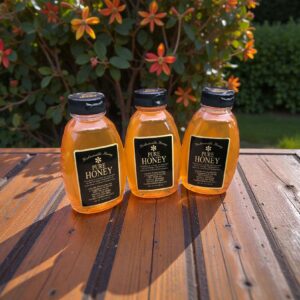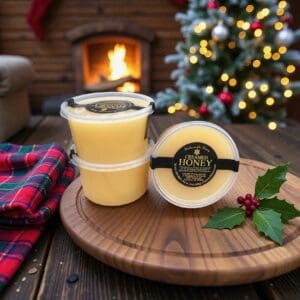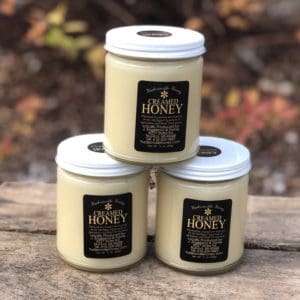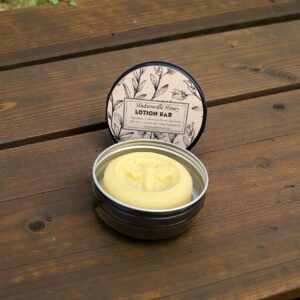We often get asked “what do your bees do in the winter?”. Given the rather brutal winters we experience here in the West Michigan area, these questions are often prompted by concern for the bees’ welfare. The quick answer to the question is that bees eat lots of honey and try very hard to keep warm. However, what is actually going on within a honey bee colony during the winter months is a bit more complex than that. In this article we’ll attempt to give you a basic understanding on what is going on in the hive during the winter.
After the first frost eliminates forage for the bees in the fall, the queen bee will reduce the number of eggs she lays each day. As the weather begins to remain consistently cold (< 50 Fahrenheit) the bees contract into a tight cluster on the combs and the queen stops laying altogether. This normally occurs in the November time-frame here where we live. If the cluster is healthy (e.g. strong enough population, and a ready supply of honey) the internal hive temperature will be maintained in the range of 54 – 94 degrees Fahrenheit. The cluster has a very distinct structure where in the center of the cluster it is warmest, the queen resides. A portion of the cluster must remain in contact with honey for the duration of the winter. As the bees consume honey their bodies vibrate which generates the heat. In order to remain in contact with the honey the cluster will gradually keep moving upward among the combs. If the honey is not situated properly (e.g. above the cluster) the cluster will eventually lose contact with the honey stores and perish. This can happen even though 10s of pounds of honey might be stored horizontally to the left or right within inches of the cluster.
As the days become longer, normally in late January, early February here, the queen will resume laying eggs in a very restricted pattern in the center of the cluster. Once brood is present the worker bees will maintain a temperature of 94 degrees in the center of the cluster, even if it is 5 degrees outside! These new bees will eventually replace the fall bees as they begin to expire. Occasionally, on a warmer winter day when there is plenty of sunshine and a good wind break, the colony might be enabled to take what is referred to as a “cleansing flight” This basically means they will fly briefly outside of the hive and defecate. After being cooped up for weeks and sometimes months at a time, this is an important event that increases the colony’s ability to survive the winter. If the bees do not relieve themselves outside of the hive, they may eventually do so within the hive which usually spells doom for the colony.
During the early days of Spring the worker bees will start to forage for early pollen sources as they become available. Here in Michigan that is typically pollen from maple trees and pussy willows, and eventually dandelions. This can happen as early as March here in Michigan, but is normally late March, early April. The pollen is very important as the bees turn it into “bee bread” which is fed to the developing brood. Some beekeepers will feed their bees a pollen supplement in the early Spring in order to kick start brood rearing and have a more populous colony in April/May.
That is a short overview of how honey bees manage to make it through our long Michigan winters! For beekeepers the key variables to get under control for successful wintering are 1) knock back the varroa mite levels. Hives with high mite counts will inevitably not make it through the winter. 2) make sure the hive has plenty of honey/pollen stored. How much honey really depends on the locality, but here in Michigan we winter in double deeps and make sure the hives weight at least 130 pounds total, including the woodenware. 3) Make sure the hive entrances are positioned facing to the south or east and have a good windbreak. This will help facilitate cleansing flights later in the winter. We also wrap and insulate the tops of our colonies as this has proven to give us better results.







Do you offer private label pricing? or Can I purchase your honey without the label? I currently sell at farmers markets, craft shows, and church events. Wild Flower, Clover, 8oz,16oz,32oz
Thanks for the note John. We operate under Michigan’s cottage food law and as such are not allowed to sell without a label. Sorry about that.
I have been reading more about the health benefits of 100% pure honey. What I am gathering is that most store bought brands are non GMO and with the pollen removed. Can you tell me if your honey is 100% pure unprocessed honey?
hello – i am interested in volunteering at your bee farm in order to learn more about these awesome little workers. is something like this possible? i will gladly sign a waiver of responsibility if safety is a concern. thank you for your consideration!